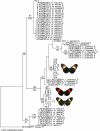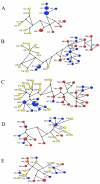Gene flow and the genealogical history of Heliconius heurippa
- PMID: 18454858
- PMCID: PMC2391162
- DOI: 10.1186/1471-2148-8-132
Gene flow and the genealogical history of Heliconius heurippa
Abstract
Background: The neotropical butterfly Heliconius heurippa has a hybrid colour pattern, which also contributes to reproductive isolation, making it a likely example of hybrid speciation. Here we used phylogenetic and coalescent-based analyses of multilocus sequence data to investigate the origin of H. heurippa.
Results: We sequenced a mitochondrial region (CoI and CoII), a sex-linked locus (Tpi) and two autosomal loci (w and sd) from H. heurippa and the putative parental species, H. cydno and H. melpomene. These were analysed in combination with data from two previously sequenced autosomal loci, Dll and Inv. H. heurippa was monophyletic at mtDNA and Tpi, but showed a shared distribution of alleles derived from both parental lineages at all four autosomal loci. Estimates of genetic differentiation showed that H. heurippa is closer to H. cydno at mtDNA and three autosomal loci, intermediate at Tpi, and closer to H. melpomene at Dll. Using coalescent simulations with the Isolation-Migration model (IM), we attempted to establish the incidence of gene flow in the origin of H. heurippa. This analysis suggested that ongoing introgression is frequent between all three species and variable in extent between loci.
Conclusion: Introgression, which is a necessary precursor of hybrid speciation, seems to have also blurred the coalescent history of these species. The origin of Heliconius heurippa may have been restricted to introgression of few colour pattern genes from H. melpomene into the H. cydno genome, with little evidence of genomic mosaicism.
Figures


Similar articles
-
Hybrid speciation in Heliconius butterflies? A review and critique of the evidence.Genetica. 2011 May;139(5):589-609. doi: 10.1007/s10709-010-9530-4. Epub 2010 Nov 28. Genetica. 2011. PMID: 21113790 Free PMC article. Review.
-
Hybrid incompatibility is consistent with a hybrid origin of Heliconius heurippa Hewitson from its close relatives, Heliconius cydno Doubleday and Heliconius melpomene Linnaeus.J Evol Biol. 2005 Mar;18(2):247-56. doi: 10.1111/j.1420-9101.2004.00839.x. J Evol Biol. 2005. PMID: 15715831
-
Genome-wide patterns of divergence and gene flow across a butterfly radiation.Mol Ecol. 2013 Feb;22(3):814-26. doi: 10.1111/j.1365-294X.2012.05730.x. Epub 2012 Aug 25. Mol Ecol. 2013. PMID: 22924870
-
Genetic evidence for hybrid trait speciation in heliconius butterflies.PLoS Genet. 2010 Apr 29;6(4):e1000930. doi: 10.1371/journal.pgen.1000930. PLoS Genet. 2010. PMID: 20442862 Free PMC article.
-
Review. Hybrid trait speciation and Heliconius butterflies.Philos Trans R Soc Lond B Biol Sci. 2008 Sep 27;363(1506):3047-54. doi: 10.1098/rstb.2008.0065. Philos Trans R Soc Lond B Biol Sci. 2008. PMID: 18579480 Free PMC article. Review.
Cited by
-
Hybrid speciation in Heliconius butterflies? A review and critique of the evidence.Genetica. 2011 May;139(5):589-609. doi: 10.1007/s10709-010-9530-4. Epub 2010 Nov 28. Genetica. 2011. PMID: 21113790 Free PMC article. Review.
-
Genomics Reveal Admixture and Unexpected Patterns of Diversity in a Parapatric Pair of Butterflies.Genes (Basel). 2021 Dec 17;12(12):2009. doi: 10.3390/genes12122009. Genes (Basel). 2021. PMID: 34946956 Free PMC article.
-
Adaptive introgression across species boundaries in Heliconius butterflies.PLoS Genet. 2012;8(6):e1002752. doi: 10.1371/journal.pgen.1002752. Epub 2012 Jun 21. PLoS Genet. 2012. PMID: 22737081 Free PMC article.
-
Diversity in warning coloration: selective paradox or the norm?Biol Rev Camb Philos Soc. 2019 Apr;94(2):388-414. doi: 10.1111/brv.12460. Epub 2018 Aug 27. Biol Rev Camb Philos Soc. 2019. PMID: 30152037 Free PMC article. Review.
-
Multilocus analysis of divergence and introgression in sympatric and allopatric sibling species of the Lutzomyia longipalpis complex in Brazil.PLoS Negl Trop Dis. 2013 Oct 17;7(10):e2495. doi: 10.1371/journal.pntd.0002495. eCollection 2013. PLoS Negl Trop Dis. 2013. PMID: 24147172 Free PMC article.
References
-
- Arnold ML, Bennett BD. In: Hybrid Zones and the Evolutionary Process. Harrison RG, editor. New York, Oxford University Press ; 1993. Natural hybridization in Louisiana Irises: genetic variation and ecological determinants; pp. 115–139.
-
- Howarth DG, Baum DA. Genealogical evidence of homoploid hybrid speciation in an adaptive radiation of Scaevola (Goodeniaceae) in the Hawaiian islands. Evolution. 2005;59:948–961. - PubMed
-
- Rieseberg LH. Hybrid origins of plant species. Ann Rev Ecol Syst. 1997;28:359–389. doi: 10.1146/annurev.ecolsys.28.1.359. - DOI
Publication types
MeSH terms
Substances
LinkOut - more resources
Full Text Sources
Miscellaneous

